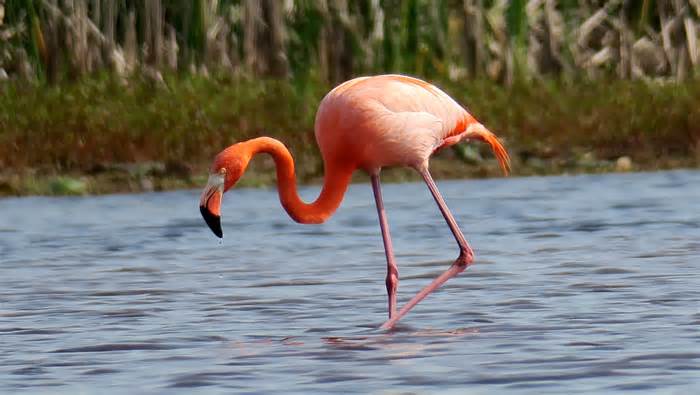A solitary flamingo flew in the St. Petersburg National Wildlife Refuge. Marks with Hurricane Michael in 2018, a refugee from the storm. He’s gone.
The flamingo earned a nickname, Pinky, and the most common question from guests at the front door and in the guest center temporarily was “where is Pinky today?Actually, the bird is neon orange or bright pink, but it is called “Pinky”. it has stalled, and birders across the United States will be able to catch a glimpse of this rare guest.
Almost five years later, Pinky, the famous flamingo, is spotted in open bodies of water along Lighthouse Road and, infrequently, in the giant pool in front of the San Marcos lighthouse, depending on water levels. If you’re lucky, Pinky is close to the path or a trail, but it’s rarely far away in the middle of a pond and only a dot of its pink/orange color is visible to the naked eye.
To practice Pinky you need good binoculars, a telescope or a camera with a resistant zoom. Sometimes, Pinky leaves the shelter for a few days or weeks, to faithfully return to the Lighthouse Road area.
Pinky will be an American flamingo (also as Caribbean flamingo), one of the six species of flamingos in the world.
Pinky can be seen in shallow water tapping her foot with her webbed paws to stir food. Then, with his head slightly tilted under the surface of the water, he waves his beak back and forth. Pinky uses her tongue to pump agua. de her beak while comb-like plates along the edge of the beak clean the water and trap the food in its appearance.
Like other flamingos, Pinky feeds on algae, small seeds, fly larvae and small crustaceans such as brine. This food contains colored pigments called carotenoids, which is why tomatoes are red and carrots orange. Pinky metabolizes those pigments, giving her feathers their distinctive color. Pink and orange colors.
Pinky, the first wild fly recorded in the domain since 1995, when Hurricane Allison hit. Before that, a flamingo was seen in 1972, shortly after Hurricane Agnes. All the storms have bypassed the Yucatan Peninsula in Mexico or Cuba, regions known for their abundance of wildlife. flamingos.
It will have to be some kind of trip: flying with a hurricane!So far we have only had one or two flamingos in our domain at a time. An organization of flamingos is known as “extravagance. “
For a long time, flamingos were thought to be non-native Florida birds, only seen on road attractions and zoos, as this lanky bird has inexplicably become one of Florida’s iconic photographs alongside palm trees, oranges, alligators and bathers.
But many birders now argue that flamingos once originated in the southern tip of Florida until feather hunters killed wild populations in the late nineteenth century. So those plastic lawn ornaments aren’t out of place, of course!Most of today’s Native American flamingo populations are found in the Caribbean and Yucatan, although flamingos are beginning to repopulate in South Florida. Most of Pinky was a wild bird as it did not carry tags of any kind.
It’s easy to assign human feelings to Pinky: is he alone?Why doesn’t Pinky return to where she came from?Is Pinky disoriented?
It is difficult to perceive if Pinky has such feelings, however, Pinky affiliates with other wading birds, especially the bright pink spoonbills that inhabit the safe haven in greater numbers. Do pink birds congregate?
Flamingos live an average of 20 to 30 years, and the oldest American flamingo in captivity lives 67 years. Hopefully, the “where’s Pinky” will persist for many years in the St. Petersburg National Wildlife Refuge. Brands.
Dinner with a View: 16 of Our Favorite Beach Restaurants Around the Panhandle and Forgotten Coast
Doug Alderson is the author of award-winning books on Florida, including “Discovering the Florida Coast,” “Florida’s Rivers,” and “America’s Crocodile. “Learn more about dougalderson. net.
If you are one of the photographers tracking down a wonderful photo of the photogenic Refugio de San Marcos, share it. Send your photographs of the famous flamingo: email 2 or 3 high-resolution JPEG images (3-10 MB) to news@tallahassee. . com. Include a sentence indicating when and where the photo was taken. We’ll gather the most productive ones and publish a photo gallery to share with readers and post some print favorites in October, on the fifth anniversary of Hurricane Michael.

